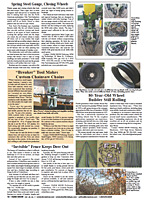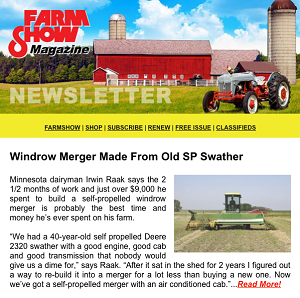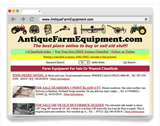You have reached your limit of 3 free stories. A story preview is shown instead.
To view more stories
(If your subscription is current,
click here to Login or Register.)
He Presses His Own Sunflower Oil
Pressing his own sunflower oil is the latest accomplishment for Michael Cohen, who describes himself as an experimental gardener. He tried growing and pressing Peredovik oilseed sunflowers a few years ago, but they were too hard to press using his hand-crank spiral press. His latest attempt yielded one pint of oil from
..........
You must sign in, subscribe or renew to see the page.

You must sign in, subscribe or renew to see the flip-book
He Presses His Own Sunflower Oil FARM HOME Food Pressing his own sunflower oil is the latest accomplishment for Michael Cohen who describes himself as an experimental gardener He tried growing and pressing Peredovik oilseed sunflowers a few years ago but they were too hard to press using his hand-crank spiral press His latest attempt yielded one pint of oil from 6 quarts of hulled culinary or “snack” sunflower seeds That was enough to meet his goal of making crackers from foods he grew—wheat sesame seeds and sunflower oil This year he hopes to grow enough sunflowers to make a gallon of oil The key to success is growing a large seed variety two pieces of equipment and taking the steps needed to create a clean product He described the process in a recent issue of Small Farmers Journal Living in Zone 5 at the northern tip of New York state’s Hudson Valley Cohen is looking for a sunflower variety that has a shorter season and yields big seeds Along with Mammoth which he grew in 2023 he planted Mongolian and a couple of other snack sunflower varieties this year “The most challenging part of the process is harvesting and drying the sunflower heads Birds start eating sunflower seeds just before they are ready Also we had a wet and cool fall last year and mold was a problem too ” Cohen says He plans to harvest the flower heads before they fully mature and cut the backs off to speed up drying on racks with a fan Once dried and threshed off the flower heads he runs the seeds through a hand-crank Corona mill he purchased earlier for other grains He sets the distance between the plates so they split the sunflower kernels without crushing them “I ended up putting the seeds through twice with the plates a little closer to get the uncracked seeds ” he adds After running them through 1/4-in and then 1/8-in screens the kernels with bits of shells go through a homemade vacuum seed cleaner he built from plans he found at www realseeds co uk/seedcleaner html With the suction from a vacuum cleaner to create an updraft the cleaner does a pretty good job of separating kernels from shells But there were still some bits of shell and Cohen wanted only kernels to press “Floatation really works well ” he says noting that when covered with water the kernels sink and shells and whole seeds float to the top They can be easily poured off and the process repeated a couple of times until only seeds are left After letting them dry completely the seeds are ready to go through a press Cohen purchased a hand-crank Piteba spiral press for less than $200 Besides the oil he ended up with a lot of oil cake which can be used for animal feed as it’s high in protein “If there are no shells in it it could be used for food such as crackers ” Cohen notes He’s eager to improve the process this year and hopes to press oil from Styrian pumpkin seeds and possibly grape seeds from a local winery He also wants to experiment with black walnuts and hickory nuts cracking them with a hammer and using floatation to hopefully yield clean nutmeats for pressing “I’m trying to adapt old-fashioned methods for the present ” he says Contact: FARM SHOW Followup: Michael Cohen mdcmd1948@yahoo com
To read the rest of this story, download this issue below or click
here to register with your account number.





